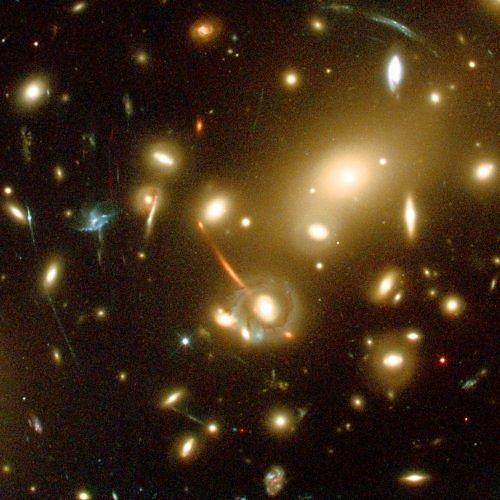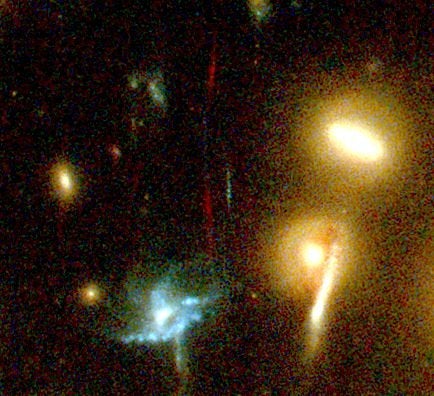Using a combination of the Advanced Camera for Surveys aboard NASA’s Hubble Space Telescope and the Keck telescopes in Hawaii, a team of astronomers discovered an ancient galaxy lying roughly 13 billion light-years away. This great distance corresponds to an infant time, only 750 million years after the Big Bang, when the universe was a mere 5 percent its current age. The discovery of the oldest galaxy ever found has given astronomers their first glimpse of the cosmic dawn.
The primeval galaxy lurks so far back in time that even the most powerful telescopes are incapable of seeing it. The team made the discovery while viewing a nearby cluster of galaxies named Abell 2218. The galaxy cluster is so massive that its gravitational field both deflects and magnifies light streaming past it. In fact, the faint light from the distant galaxy, intensified and tripled by the cluster, shows up as three separate but identical images on the sky — an effect of gravitational lensing first predicted by Albert Einstein.
The astronomers were able to determine the galaxy’s distance by analyzing how much its light had been redshifted along its journey. With a redshift between 6.6 and 7.1, the galaxy is the most distant source ever observed. “We are looking at the first evidence of our ancestors on the evolutionary tree of the entire universe,” says Frederic Chaffee, director of the W. M. Keck Observatory.
Shortly after the Big Bang, conditions were too hot for neutral atoms to form. The universe was a sea of plasma in which independent protons and electrons roamed. After about 300,000 years, the cosmos cooled enough that these particles could bond into neutral hydrogen atoms. This transition created the relic radiation we now detect as the all-pervasive cosmic microwave background. But the glow faded quickly as the universe expanded and cooled, plunging the cosmos into darkness for nearly half a billion years. Cosmologists refer to this period of cosmic history as the Dark Ages.
All the facts suggest the newly found galaxy lived during the end of the reionization era. First of all, with a remarkably meager 2,000-light-year diameter, the galaxy supports the bottom-up model of galaxy formation, which maintains the first galaxies were small. Second, the fledgling galaxy is actively producing stars; astronomers believe the star-production rate of the earliest galaxies was ten times that of galaxies today. Finally, the galaxy is emitting intense ultraviolet light, a phenomenon expected of early generation stars containing very low amounts of “metal” — elements heavier the helium.
The discovery underscores the incredible usefulness of gravitational lensing as a tool for finding extremely distant galaxies that otherwise would remain inaccessible. “Without the magnification of 25 afforded by the foreground cluster, this early object could simply not have been identified . . . with the present telescopes available,” explains Jean-Paul Kneib of the California Institute of Technology, Pasadena, the lead author of the paper detailing the discovery.
Further observations of the ancient galaxy promise to yield a wealth of cosmological information, including details of reionization and clues to the process of early galaxy formation. Most importantly, astronomers now know that it is indeed possible to gaze back in time to the first lights that illuminated a vast and breaking darkness.











